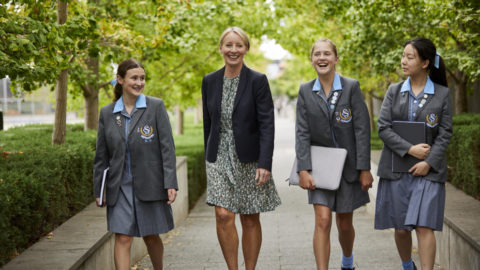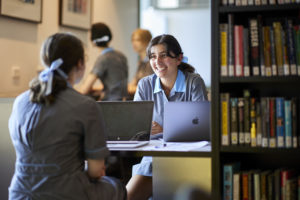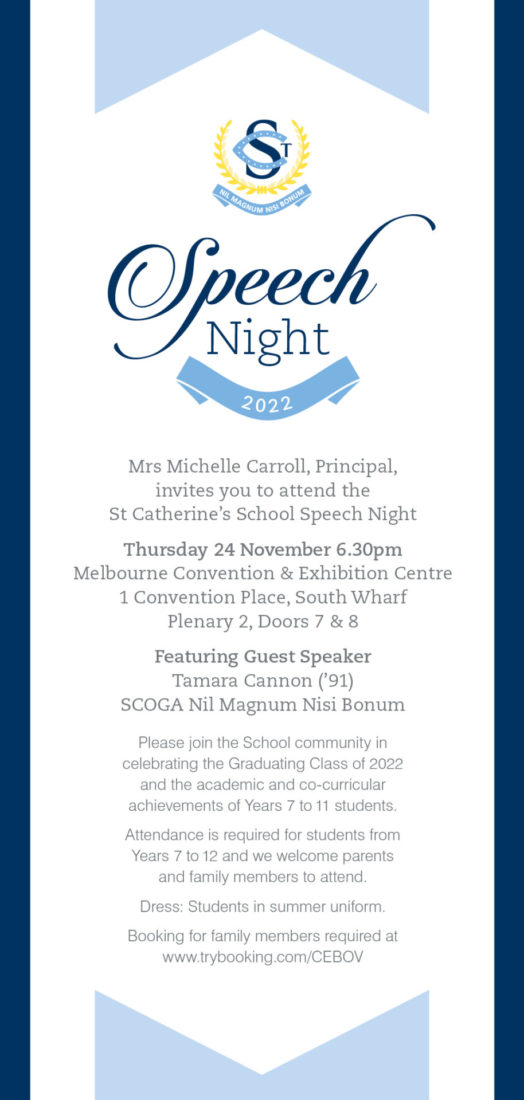NAPLAN trends reveal girls months ahead of boys

Next Thursday 24 November at 6.30pm, our Senior School will celebrate its annual Speech Night. The event provides a wonderful opportunity to recognise the academic, co-curricular, service and leadership achievements of all students across Years 7 to 12. It also provides us with a final occasion to celebrate and thank our graduating Class of 2022, inclusive of the Address by School Co-Captains, Madeline (Maddie) Powell and Angela Yu.
The Keynote Address will be provided by St Catherine’s Old Girl, Miss Tamara Cannon (’91), Founder and CEO of Lille Fro, an Australian charity which funds education for children and skills training for adults living in extreme poverty in some of the most remote places on the planet. Tamara’s endeavour is well known to the students, with cohorts over many years raising funds to support the educational needs of children connected with her charity in Nepal.
Student attendance is required at Speech Night. The evening is an important occasion in our annual calendar, providing the opportunity to contribute to the St Catherine’s School culture of celebrating and supporting the achievements of young women. Families are encouraged to book their tickets online here.
For this special occasion, the School will gather at the Melbourne Convention and Exhibition Centre (MCEC). This is the first time we have used this amazing venue, with easy parking and the opportunity for families to dine together before or after the event, at one of the many restaurants nearby. All MCEC ticket holders attending the Speech Night will also receive a 20% discount to the Monet and Friends Exhibition at THE LUME Melbourne.
As you arrive at the Melbourne Exhibition Centre next Thursday, I encourage families to appreciate the magnificent design features of this building. The MCEC is a Melbourne icon that reflects our wonderful city in every detail – from the design of the distinctive exterior to the colours and materials used in the impressive interior.
As you step inside MCEC, and you will find a design dedicated to our state:
- The green chairs in the Plenary represent the grass of the MCG;
- The wood panelling in the Sovereign Room is from one eucalyptus tree sourced from Tasmania;
- The carpet in the Melbourne Room features a rose pattern that draws on the famous roses of Flemington;
- The orange walls in the Convention Centre Foyer are a nod to the ship building heritage of the Yarra River, and the 3mm thick polished aluminium sheets represent fishing nets;
- The Main Foyer floor pattern (21,200 coloured floor tiles in total) is derived from the mapping of water flow into Port Phillip Bay from the various waterways surrounding Melbourne; and
- The unique colour on the building exterior was selected to reflect the ‘Gold Rush.’
The building was opened in 1996 and has since hosted 20,000 events, attracting millions to the economy, most notably the World AIDS Conference in 2014. The role MCEC plays in building Melbourne’s knowledge and business economy is extraordinary. Millions of local, national, and international visitors coming through the doors at MCEC, add over $1B to the Victorian economy in terms of accommodation, food, shopping, and tours.
It will be a privilege to host our 127th Speech Night at the MCEC and mark such an important School occasion in one of Melbourne’s outstanding facilities.
Gender Trends in NAPLAN
Over recent weeks, the media has highlighted NAPLAN results conducted this year. Whilst the national comparison data versus individual schools have not yet been released, the recent gender trends have been highlighted. These trends support previous research from other studies, showing that girls’ brains commence the reorganisation and pruning of typical/normal brain development earlier than boys’ brains.
With the wisdom of significant research in brain science today, we know girls reach maturity more quickly than boys. With this in mind, and given the learning opportunities at St Catherine’s, we are well positioned to harness the benefits of single-gendered classrooms.
The analysis of 2021 and 2022 NAPLAN gender trends and results reveals a genuine need to purposefully understand the educational needs of both boys and girls. For example, the gender gap this year for reading was over five months of equivalent learning in favour of girls in Years 3. By Year 9, the gap in reading abilities increased to 10 months of equivalent learning. Worryingly for the educators of boys, the widest gender gap is still clearly associated with the Writing Test, with girls performing seven months ahead of boys in Year 3, and this range increases to 20 months in Year 9. It seems, generally, boys struggle to keep up with the increased writing demands in the transition from primary to secondary school.
In recent weeks, the NAPLAN gender trends have led to media headlines such as: “The trouble with boys starts before they step into the classroom” (AFR, 4.11.22) with comments such as: “Boys are behind girls academically from the get-go. And by the time they get to Year 9, they have fallen so far behind their female schoolmates that the gap seems almost irredeemable.”
Or “Boys literacy gap exposes school fads and failures” (AFR, 31.10.22) with comments such as “Shockingly, more than 20 per cent of the nation’s 15-year-old boys are unable to pass the low bar that is the minimum writing standard for their age. In the same cohort, 13.5 per cent of boys also failed to reach the minimum reading standard – the worst result since NAPLAN was introduced in 2008.”
Finally, “Why boys are falling behind at school” (SMH 2.11.22) with comments such as “Boys’ underperformance is especially evident with Year 9 writing, where only 81.6 per cent of boys reach the minimal level, compared with 90.8 per cent of girls.”
Wearing my ‘Girls’ School Principal’s Hat’ it raises the question why media outlets don’t flip the story to highlight the success of girls in the NAPLAN literacy testing, instead of bemoaning the poor performance of boys. The NAPLAN trends reveal that girls are outstripping boys in reading, writing, and spelling – isn’t this worth part of the story headline?
 Such trends also raise the importance of tailoring academic programs for girls. One questions how the co-educational learning environment manages such a vast range of abilities, without pitching the lesson towards the boys’ literacy levels, instead of the higher ability of the girls. The consideration of co-ed verses single-sex education remains a hotly debated topic, with parents encouraged to always look beyond marketing material, and understand deeply what is actually happening in the classroom juggle of such disparate gender literacy levels.
Such trends also raise the importance of tailoring academic programs for girls. One questions how the co-educational learning environment manages such a vast range of abilities, without pitching the lesson towards the boys’ literacy levels, instead of the higher ability of the girls. The consideration of co-ed verses single-sex education remains a hotly debated topic, with parents encouraged to always look beyond marketing material, and understand deeply what is actually happening in the classroom juggle of such disparate gender literacy levels.
The English Program at St Catherine’s stands the test of time, with outstanding VCE and NAPLAN results consistently over a number of years. The success of the Program is underpinned by the strength of the Reading Program implemented. This includes the 2022 implementation of the ‘Game of Loans’ Library Reading Program across Years 7 and 8. The Program’s primary focus is increasing reading levels, coinciding with the DEAR Program (Drop Everything And Read), and combined with the appropriate messaging home at the Terms 1 and 3 Parent/Teacher/Student Conference, asking “What is your daughter reading today?”
With only a few weeks of school left, girls are encouraged to organise their holiday reading now. I encourage them to call into the Barbreck and Nicholas Libraries and speak to Mrs Requin and Ms Dammery for some recommendations on books and genres to explore.



